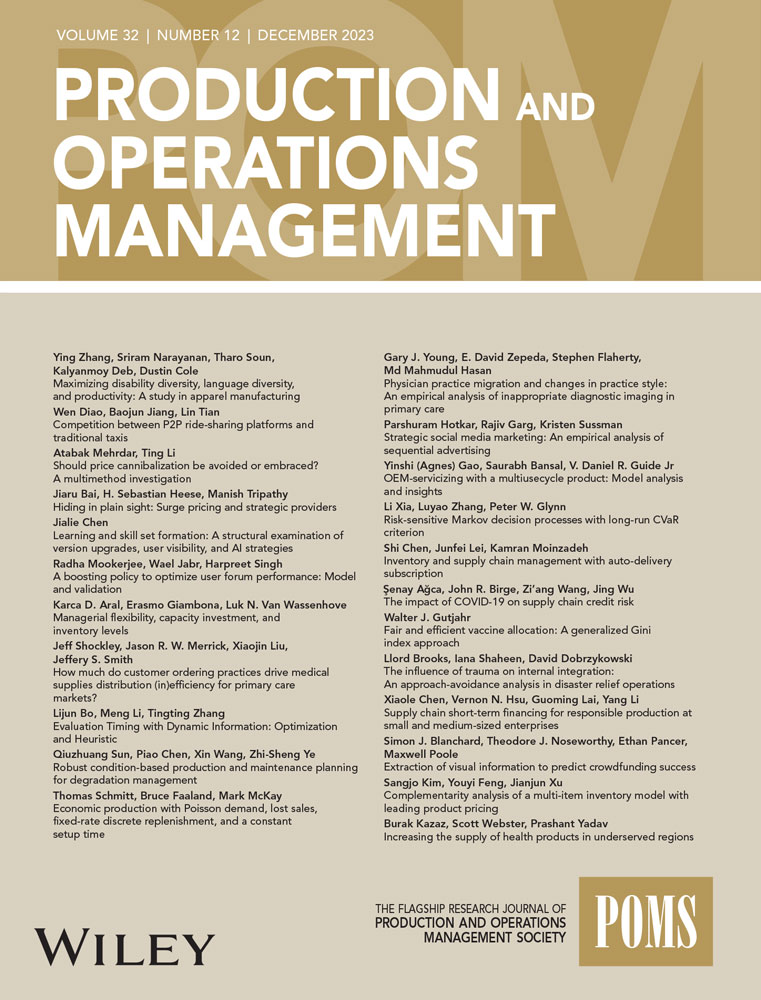EXPRESS: Regulation of Privatized Public Service Systems
IF 4.8
3区 管理学
Q1 ENGINEERING, MANUFACTURING
引用次数: 0
Abstract
To alleviate the financial shortage for public service provision, a government agency may jointly finance, own, and run a service system with a private firm (in the manner of a joint venture) or delegate service provision to the firm subject to regulation in service price or wait time. We model the service system as a queueing system in which customers are heterogeneous in service valuation and sensitive to price and delay. While the government aims to maximize social welfare, the firm's goal is to maximize profit. Hence, the joint venture has the objective of a mix of profit maximization and social welfare creation. Under the regulation, two types of interaction between the government and the firm, i.e., sequential move (in the absence of the government's myopic adjustment) and simultaneous move (in the presence of myopic adjustment), are considered. We find that while wait time regulation is more efficient than price regulation in the presence of myopic adjustment, the relationship is reversed in the absence of myopic adjustment. Somewhat surprisingly, price regulation with myopic adjustment may backfire. However, in some instances, the government must take a large share in a joint venture to achieve the same performance under price regulation without myopic adjustment. Our work uncovers whether the government adopts myopic adjustment plays a critical role in choosing the regulation instrument.快讯对私有化公共服务系统的监管
为了缓解提供公共服务的资金短缺问题,政府机构可以与私营企业(以合资企业的方式)共同出资、拥有和运营一个服务系统,或者委托私营企业提供服务,但服务价格或等待时间须受监管。我们将服务系统建模为一个排队系统,在这个系统中,客户对服务的评价是异质的,对价格和延迟也是敏感的。政府的目标是社会福利最大化,而企业的目标是利润最大化。因此,合资企业的目标是利润最大化和创造社会福利。在管制下,我们考虑了政府和企业之间的两种互动,即顺序移动(在政府不近视调整的情况下)和同时移动(在存在近视调整的情况下)。我们发现,在存在近视调节的情况下,等待时间调节比价格调节更有效率,但在不存在近视调节的情况下,两者的关系则相反。令人略感意外的是,有近视调节的价格监管可能会适得其反。然而,在某些情况下,政府必须在合资企业中占有较大份额,才能在不进行近视调整的情况下实现与价格管制相同的绩效。我们的研究揭示了政府是否采取近视调整在选择调控工具时的关键作用。
本文章由计算机程序翻译,如有差异,请以英文原文为准。
求助全文
约1分钟内获得全文
求助全文
来源期刊

Production and Operations Management
管理科学-工程:制造
CiteScore
7.50
自引率
16.00%
发文量
278
审稿时长
24 months
期刊介绍:
The mission of Production and Operations Management is to serve as the flagship research journal in operations management in manufacturing and services. The journal publishes scientific research into the problems, interest, and concerns of managers who manage product and process design, operations, and supply chains. It covers all topics in product and process design, operations, and supply chain management and welcomes papers using any research paradigm.
 求助内容:
求助内容: 应助结果提醒方式:
应助结果提醒方式:


